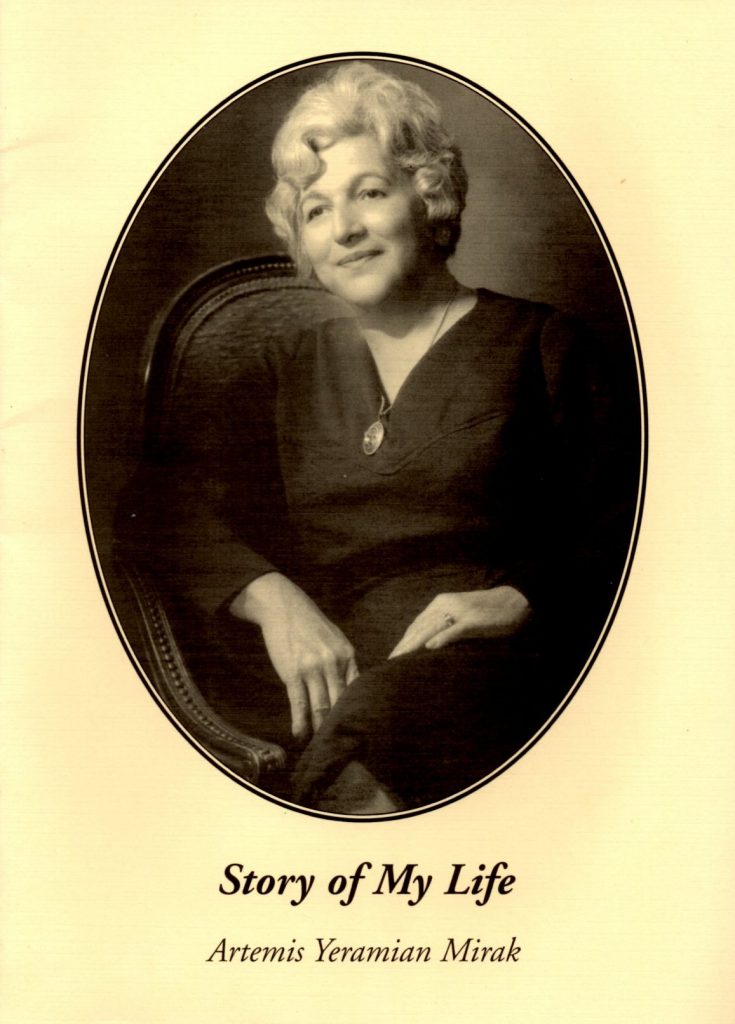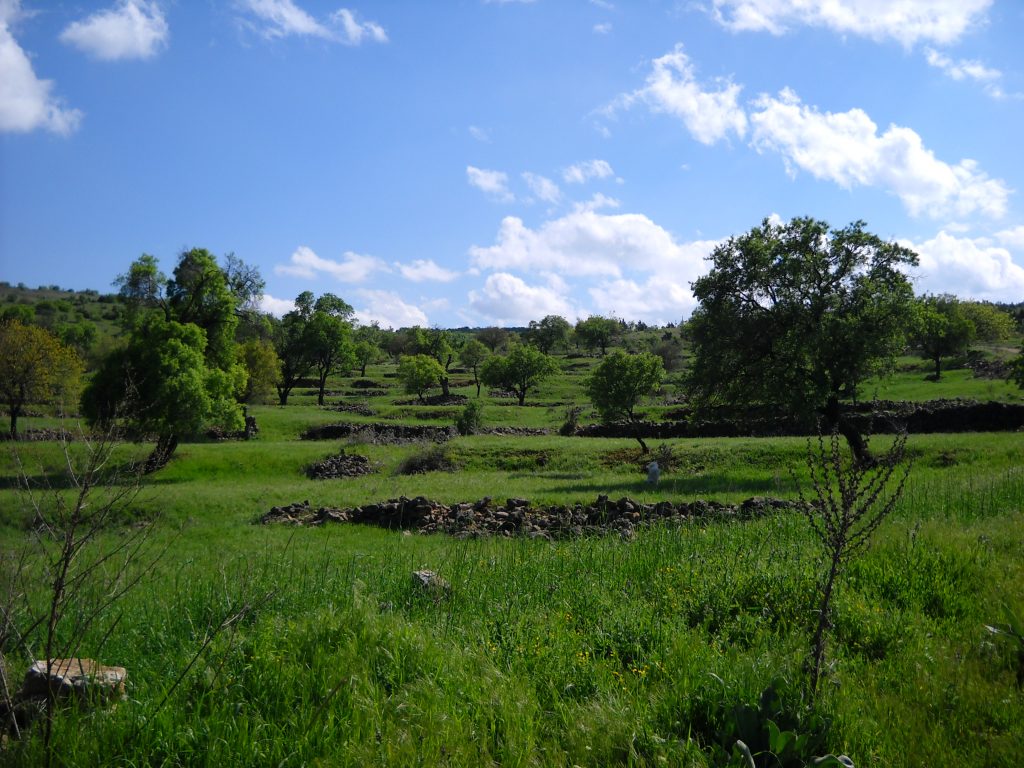In 2011 the Armenian-American journalist and historian Muriel Mirak(ian)-Weißbach visited this village and found only three siblings and their families. In 1915, there were 300 Armenian inhabitants.
Below, with the kind permission of Muriel Mirak-Weißbach, we publish an excerpt from the memoirs of her mother, Artemis Yeramian Mirak. She is a survivor of the Ottoman-Young Turkish genocide against the Armenians.

Artemis Yeramian Mirak: Story of My Life
I was born on November 15, 1915(1), in the small village called Tsak, near the town of Arabkir, Turkey. My father, who had been away to the United States, for 15 years, had returned to his native land in 1910, to be with his family, and perhaps persuade his father and mother to leave Turkey and go to America. He was married to Mariam Dedekian, one of the prettiest girls in the village. They both came from middle class families. They were landowners, and my grandfather, Krikor Yeramian, was the town treasurer, who would lend money to young men to go to America, to work and make money, and help their families at home. He was very secure and comfortable with his native land, so why should he go off to a foreign land? So he persuaded my father, Garabed, the only son, to stay in Turkey, and raise a family and live together.
My mother, Mariam, lived with her in-laws, and obeyed whatever her in-laws wanted her to do. That was the custom: the good ‘hars’. The bride – she was always introduced to outsiders as the ‘hars’, the bride of the family, no matter how old she was or how many years she had been a bride. She was always our ‘hars’.
My mother had children, but none of them lived. When I was born, my grandmother Maigir made a Novena, ‘Ooquth’ in Armenian. She went and collected forty different pieces of silver from the silversmith or neighbors, and had a bracelet made to be worn by the infant. Of course, it was blessed by the church priest and my mother inscribed ‘Artemis’ on it, and when I was christened, the word, ‘aprisse’ – ‘May you live.’ They also had a pinafore made with fort different kind of fabrics. The baby wore the dress over and over again. My family was very happy to have a living child, even though I was not a boy. Boys were always more desirable, because they carry the family name. Anyway, I lived.
In 1913, the Turkish government closed all its doors. No one could leave the (Armenian) country, no communication with the outside world. No letters came in or went out of the country. This was the beginning of the plan, the ‘Genocide’.
I was just an infant when the mass killings started, 1915-1916. Our village people were gathered in the church hall, all the men, women and children were kept there for days. Then the gendarmes (…) took groups at a time, to a distance of five or ten miles and shot them to death. My mother, my grandmother and other women, and children, were grouped, and shot to death. My mother held me, her infant baby Artemis, to her breast, so that the baby would die with her, but the bullet missed me.
Dikin [Mrs.] Bakerian survived the massacre. She saw me, knew I was alive, but where could she go with a little baby? If it cried, she would be caught, so she left me there with the dead bodies. She made her escape to the nearest village and was saved by Turkish neighbors.
A few days later, a Turkish shepherd grazing his sheep, heard an infant crying among the dead bodies. He picked the little infant and carried her, and left her on the steps of Turkish mosque. I don’t know for how many days this infant was left outdoors. Then, one day came a gendarme of this town, called Omar. He took pity, seeing this infant, and carried her home, and asked his wife, Gulnaz, to take her in. They had no children. She refused to take her in, she was not going to take a ‘giavour’ [‘infidel’] child, a Christian, and said she was too old to take care of an infant. Finally, she consented to keep her overnight.
The next morning, she took the child and left her at the doorstep. While talking with her neighbors, sitting there, what happened was, the little one crawled over to her and held onto her skirt. Right then, and there, tears came to Gulnaz’ eyes, and she vowed that Allah had sent this child to her, and that she would love me and care for me as long as she lived. They named me Noveria, and I was known by that name.
She loved me dearly, and I grew up and called her ‘Anne’, which means ‘mother’ in Turkish. I had the best of everything: beautiful clothes – I was the only baby who wore red buckled shoes – and the best of food. You see, the gendarmes lived very well, they had a lovely home, garden and vineyards. I spoke only Turkish. I remember at dinner time, that is, the evening meal, the ‘Kazah’ would sing the evening prayer form the minaret, and then we would start to eat our meal. This was a ritual.
I didn’t know I was an Armenian child, they kept it secret from me. Then, about 1917, or so, the Armenians, who had survived returned to their homes. There was nothing left but bare walls. In order to live, some of these women went out to the Turkish homes, to do housework, and got food in return. It happened that one of my aunts, Margret Dedekian, came to our house. She recognized me immediately, but Gulnaz Hanim denied that I was an Armenian child. Then, after a fashion, she told the ladies how she had found me. She showed them the little pinafore dress, all stained with blood, and my silver bracelet. There was a warm friendship between these ladies. My relatives did their housework, and went home happy, knowing that I, too, was alive, and well taken care of.
They went back to their village and told my cousin, Joovar Millian, that Artemis was alive, and living with a Turkish family.
Shortly after 1917, the Armenian who had survived the Genocide were allowed to travel freely. My cousin Joovar came to visit me, but I did not know who she was. I remember being very shy and uneasy with her. You see, I had been told I was Turkish, and she was ‘giavour’, that means Christian. She made many visits, it was quite a distance. She walked all day to make the trip. She did not have a horse or a buggy, she just walked all day, just to come to see e. Joovar’s father and my father were brothers. Her father had died and she lived with her mother and grandmother. My cousin Joovar had no children of her own. She had taken in an orphaned half-sister, Siranoush, Boghos, a nephew of her husband, and lived in her house in the Tsak village. She had lots of farmland which belonged to her family and mine, with vineyards. Her husband was in America, but she had no communication with him until 1918 or 1920.
One day I was playing with the children, and I came home to find lots of people in our house, and I wanted to know why. My father, the Turkish gendarme Omar, had taken ill and died suddenly. To this day, I remember all the village people coming, crying, the old people huddled together in grief. I was crying too. I had no father to take me horse-back riding or buy me pretty clothes. What was to become of me? But I had my Anne, who loved me more than ever. She was a very warm and loving person, always cuddling me, always looking after my needs. I loved her dearly. My Anne, my mother.
Perhaps a year or two passed. My cousin still visited me, and they were all on friendly terms. When Omar was alive, he had warned my cousin Joovar, she should never, never think of taking me away from him, he would have killed her instantly. This warning didn’t scare her, she kept coming as often as possible. When he died, things changed: the new husband of Gulnaz didn’t care about me, as he had children of his own. They talked it over with my cousin Joovar. If she wanted me, she could have me.
Also, at that time the Turkish government passed a new law, saying, if there were any Armenian children living with Turkish families, they should be returned to their Armenian relatives – mothers, sisters, brothers, or cousins – who would claim them rightfully by law. This was good faith: out of all evil, some good comes.
So my Anne dressed me in pretty clothe, beautiful silk dress and red shoes. She and her husband took me to Tsak village. We rode on horseback. I rode in front of the saddle with my mother and her new husband led us. I don’t remember how long a journey it was. We reached the village at dusk, and it happened to be the day before Easter. All the people in the village came to welcome us, with home-made goodies, cheoreg [çörek], cheese, eggs, and Kharma, cooked lamb. We had a great dinner. What a celebration! Everyone here was Armenian, and I could not understand one word of Armenian.
The next morning, my Anne and her husband left, for [Arm. Akn, Trk.: Eğin today: Kemaliye], their home town. I cried and cried after them. I wanted to go back with them. I stayed. I had to. The only person I knew was Joovar, Abla [Trk.: older sister], my cousin. I held onto her wherever she went. There was Siranoush (her half-sister), a couple of years older than I, and Boghos, the nephew of her husband.
Siranoush did not like me, she used to call me ‘Turk’ because I did not speak Armenian. Within six month or so, I had begun to learn to speak Armenian. Wen went to an Armenian school in the village and I made many friends there. There was Deran [Tiran], Sarkis, Mana, Vartan und Kourken [Gurgen]. In this village, there were only women and children, no men. I never remember seeing a wedding or a new-born baby. We who survived were orphans of the massacre.
Then, about 1922, Joovar Abla’s husband, who was in Watertow, U.S.A., sent a letter saying he wanted her to come to the U.S.A. Anna Mirakian, who had arrived in the U.S.A. in 1921, went and saw John Millian, Abla’s husband, and told him that his wife was alive and living in their village with the rest of the people. He sent another letter saying there was money to come to the U.S.A., but to leave the children there. She had lots of spunk. She wrote back and told him, ‘You either let me bring these orphans with me, or I will not come to you. Siranoush is my sister, your nephew Boghos, and Artemis, they have no one here other than me.’ He finally consented, and asked all of us to come.
All who had relatives in the U.S.A., were leaving the village. We were all coming to America. This was the summer of 1923.”
Excerpted from: Yeramian Mirak, Artemis: Story of My Life. Wiesbaden, 15 November 2000, pp. 7-10
